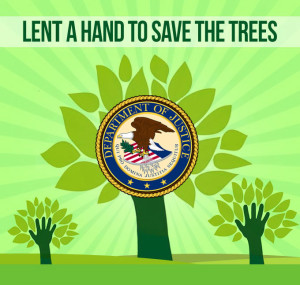 AFTER 1.5 YEARS IN COURT, A SETTLEMENT over whether the federal government will fund the destruction of hundreds of thousands of allegedly “hazardous” eucalyptus trees — and also acacia and Monterey Pine trees — has been reached. On Sept 16, 2016, after costing thousands of taxpayer dollars, and preceded by a decade of not-public-enough debate, a settlement has been reached, a determination has been rendered by the U.S. Dept. of Justice and the CAL OES (California Office of Environmental Services) presiding over this case.
AFTER 1.5 YEARS IN COURT, A SETTLEMENT over whether the federal government will fund the destruction of hundreds of thousands of allegedly “hazardous” eucalyptus trees — and also acacia and Monterey Pine trees — has been reached. On Sept 16, 2016, after costing thousands of taxpayer dollars, and preceded by a decade of not-public-enough debate, a settlement has been reached, a determination has been rendered by the U.S. Dept. of Justice and the CAL OES (California Office of Environmental Services) presiding over this case.
FEMA (the Federal Emergency Management Agency) was asked by UC Berkeley, The City of Oakland, and East Bay Regional Parks District (EBRPD), to award them a total of $5.7 million to cut down hundreds of thousands of healthy, mostly eucalyptus trees in the Oakland and Berkeley hillsides because some (many? perhaps even you?) labeled them a flammable fire hazard threatening public safety. After cutting the forests down, thousands of gallons of herbicides would be applied to their stumps — twice a year for ten years — to kill their resprouting.
Well, here it is: the judge has “vacated” the order to kill trees, rejecting the grants requests to cut down trees for supposed fire danger mitigation. The only monies that WILL be awarded will go only to East Bay Parks to clear brush (which is not species-specific).
 This landmark legal decision is an objective, third-party, government agency’s vindication of what many local environmentalists — and thousands of outraged Bay Area citizens — have been arguing for years: that deforestation is NOT fire danger mitigation. This result was not possible without the legal challenge by the local, Berkeley-based environmental group, The Hills Conservation Network.
This landmark legal decision is an objective, third-party, government agency’s vindication of what many local environmentalists — and thousands of outraged Bay Area citizens — have been arguing for years: that deforestation is NOT fire danger mitigation. This result was not possible without the legal challenge by the local, Berkeley-based environmental group, The Hills Conservation Network.
Take note, and take heart, environmentalist and activists! The little guy/gal/org with heart and reason — and love for the natural world — can triumph to preserve that world over big-monied entities, their hidden agendas, and their PR machines.
Decades of misinformation about eucalyptus trees has worked to convince too many people that this tree species (and two or three others, like Monterey Pines and Montery Cypress trees) are categorically different than other trees, and pose a public danger, despite an overwhelming amount of science, and reason, and common sense to the contrary. If people would only pause, read, and reflect on all the evidence. Well, the U.S. Dept. of Justice (DOJ) has done just this!
READ the DOJ settlement for yourself (for those with legal minds or curiosity): https://treespiritproject.com/wp-content/uploads/2016/09/FEMA-US-DOJ-NRS-1118375-v1-HCN-settlement-signed-9-16-16-copy.pdf
This week’s determination by The DOJ to NOT award FEMA emergency funds to kill trees because aren’t a fire danger emergency is not the only official determinations that deforestation does not promote fire safety. Several other reports reached this same conclusion over the years and detail how cutting down forests INCREASES fire danger by increasing winds, heat, and the growth of more flammable grasses and shrubs.
4 other official reports reach similar conclusions: killing eucalyptus trees does NOT reduce fire danger:
1) A 2009 U.S. Forest Service (AMSET division) report that UC Berkeley requested — then buried because it concluded deforestation would create other fire hazards;
2) the 1992 Mayor’s Task Force on Emergency Preparedness report on the 1991 Hills fire;
3) another, 1992 FEMA report (!), detailing the 1991 fire’s origins in grasses, then spreading to brush, then igniting houses. Eucalyptus trees were NOT blamed for this infamous fire, despite the popular misconceptions.
4) 2009 David Maloney Report, The former Chief of Fire Prevention for the Oakland Army base authored a blistering report condemning the targeting of eucalyptus trees, and even called out the native plant movement for disseminating misinformation and ignoring fire science.
QUESTION: So why the popular misconceptions about eucalyptus being dangerously flammable and responsible for the 1991 Hills fire?
ANSWER: A decades-long campaign by “native” plant advocates, aka “nativists,” dead-set on eradicating eucalyptus trees in California. Bay Area nativists also target Monterey Pine and Monterey Cypress trees which they ALSO label “non-native,” for having “invaded” from Monterey, CA — about 100 miles away (south of the Bay Area). You’d think just one of these bizarre factoids would be enough to discredit the nativist movement but, sadly, long-told lies often take time and effort to discredit. READ MORE about “Invasion Biology.”
Nativists use the powerful, primal fear of fire to frighten people and convince them to destroy their own precious forests. This SF Bay Area deforestation effort is, in effect, a gardening project on a massive scale, on your public lands. This is a belief system compelling its followers with a quasi-religious fervor to weed out literally millions of trees they hate, claim “don’t belong” and then kill them, like dandelions in a backyard lawn. But because there literally millions of fully grown, robust trees and forests, this mass killing requires millions of dollars, chainsaws, bulldozers, and thousands of gallons of herbicides made by companies like Monsanto (Roundup™) and Dow (Garlon™). READ MORE about Monsanto’s poisons and influence
How to unravel this ongoing War on Nature and its campaign of death? As always, with education, information, science, and common sense.
FACTS YOU SHOULD KNOW, especially if you don’t WHAT to think about eucalyptus trees:
1) California Bay Laurel trees contain as much or MORE “volatile” oil as eucalyptus trees.
2) “Volatile oil” is synonymous with “essential oil” but “volatile” frightens people into thinking… “Fire!” — which is why the term volatile is used by those would cut down eucalyptus trees.
3) California Bay Laurel trees grow closer to the ground than CA’s common blue gum eucalyptus (Eucalyptus globulus), so bay trees are MORE likely to be ignited in common grassland fires.
4) Many California live oak trees are stressed and diseased, but eucalyptus trees are NOT to blame.
5) Eucalyptus trees in California are well adapted to the current hot, dry climate. They may be better-suited than our beloved oaks to survive our warming climate.
6) Eucalyptus trees in California are well adapted to survive the current climate, and may be best-suited to survive our warming climate.
7) Eucalyptus trees are not a “monoculture” any more than redwoods are — but because more people like redwoods, this label is only used on eucalyptus trees. Among humans, this is called prejudice.
8) Eucalyptus trees have not eradicated any other species of plants or animals as the non-scientific term “invasive” leads people to believe; it is an epithet, not a scientific label.
Deforestation (of any tree species) has never been a wildfire mitigation policy, nor is it today. The most effective wildfire defense is creating defensible areas around houses and structures, and making structures ignition resistant from ground fuels and firebrands (embers).
This common sense approach IS supported by fire science, and detailed by U.S. Forest Service FIRE LAB scientist Jack Cohen. Cohen’s extensive research concludes, “The evidence suggests that wildland fuel reduction for reducing home losses may be inefficient and ineffective; inefficient because wildland fuel reduction for several 100 meters or more around homes is greater than necessary for reducing ignitions from flames…” READ HOW to make your home ignition-resistant, and fire science articles
You don’t need to cut down your neighborhood’s forests to be fire-safe, just make your house difficult to ignite. Dry grasses and brush and some shrubs deliver flames and embers to house more quickly than trees. Trees of all species, including the maligned eucalyptus forests of California, are less ignitable, collect more moisture, reduce winds, and thus present less fire danger than finer, faster-burning grasslands and brush fuels.
Instead of fearing what nativists want you to fear, which is an IMAGINED firey eucalyptus tree apocalypse, know what is ACTUALLY burning in current California wildfires: grassland and “native” chaparral fires, which have filled headlines in the past year, in both northern and southern California. (The Rough Fire, The Valley Fire, Yolo County fires, to name just a few.)
Not one of these 2015 and 2016 California wildfires were eucalyptus tree fires. And yet you are told by nativists to fear eucalyptus forests for being fire dangers and thus cut them down. To repeat an important fact: eucalyptus trees haven’t started one large Bay Area wildfire fire in 100 years, just been the victims of them, like other tree species have. In the final assessment, eucalyptus trees are…trees, just trees. And compared to grassland and chaparral, all trees pose less fire danger.
And yet the nativist campaign to kill eucalyptus trees (and other wild plants and animals) will continue, here in the SF Bay Area and beyond. UC Berkeley is perfectly capable of suing FEMA for its decision. For a chance, though, it’s not likely UC’s fiscal might could intimate…the Federal government. The local Bay Area chapter of the Sierra Club’s nativist leaders are predictably acting outraged at FEMA’s decision, claiming it makes no sense — by continuing to ignore fire science and reason, some of which is detailed in this essay. They remain determined to kill trees and justifying the now alarmingly widespread use of herbicides. What has happened to these supposed environmentalists who know spend so much time, energy and money killing plants (“invasives”) and animals (“pests”)? Why can’t they see they have becomes clients and apologists for poison companies like Monsanto, Dow, Syngenta, BASF, Dupont who profit millions of dollars in this self-destructive war on nature. What’s wrong with this picture? READ MORE.
All trees are grossly underappreciated ecological, environmental allies — as well as emotional and spiritual allies. They have been since the dawn of humankind. Trees have made the existence of humans possible in the first place. In today’s era of human-caused climate change — caused in large part by global deforestation — we need more trees and forests; trees cooling our lands, sequestering carbon, producing oxygen, and providing dwindling wild animal habitat, and so much more, now more than ever. READ MORE.

